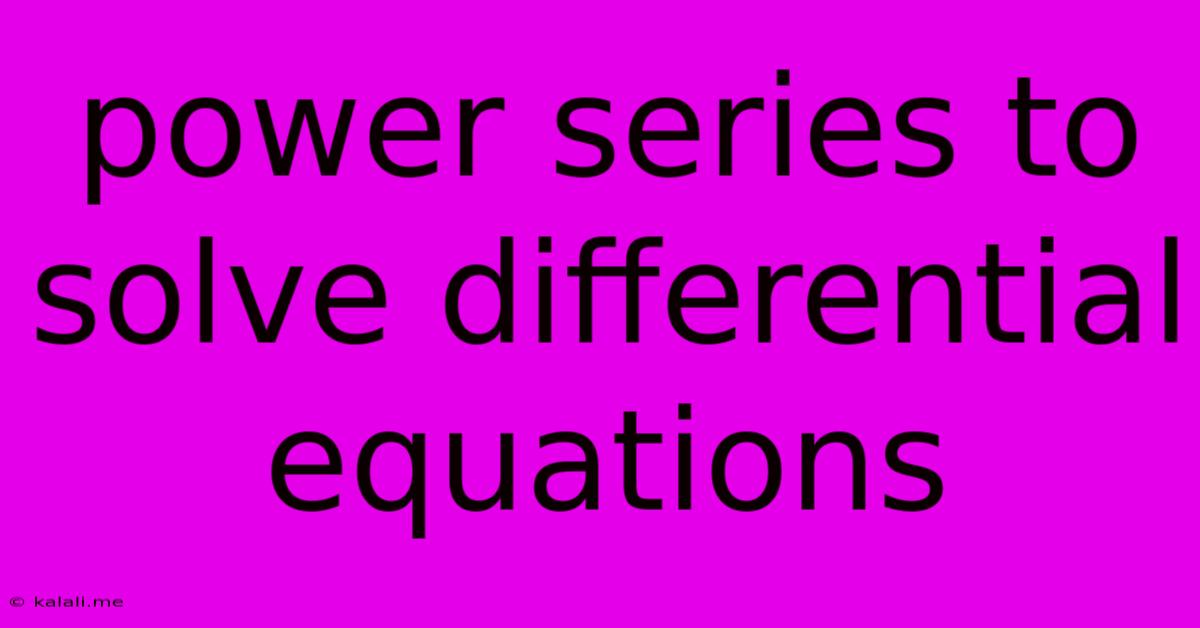Power Series To Solve Differential Equations
Kalali
Jun 04, 2025 · 4 min read

Table of Contents
Power Series Solutions to Differential Equations: A Comprehensive Guide
Meta Description: Learn how to leverage power series to solve ordinary differential equations (ODEs), including finding recurrence relations and radius of convergence. This guide covers techniques for both homogeneous and non-homogeneous equations.
Finding analytical solutions to differential equations can be challenging. While some equations yield to straightforward techniques like separation of variables or integrating factors, many others require more sophisticated methods. One powerful approach is using power series to represent the solution. This method is particularly useful for solving ordinary differential equations (ODEs) that don't have readily available closed-form solutions. This comprehensive guide will walk you through the process, equipping you with the knowledge to tackle a wide range of ODEs.
What are Power Series?
A power series is an infinite sum of the form:
∑<sub>n=0</sub><sup>∞</sup> a<sub>n</sub>(x - x<sub>0</sub>)<sup>n</sup> = a<sub>0</sub> + a<sub>1</sub>(x - x<sub>0</sub>) + a<sub>2</sub>(x - x<sub>0</sub>)<sup>2</sup> + ...
where:
- a<sub>n</sub> are the coefficients of the series.
- x<sub>0</sub> is the center of the series.
- x is the variable.
The power series converges within a certain radius of convergence, |x - x<sub>0</sub>| < R, and diverges outside this radius. Determining the radius of convergence is crucial and often involves using the ratio test.
Solving Homogeneous Linear ODEs using Power Series
Let's consider a homogeneous linear ODE with constant coefficients:
a<sub>n</sub>y<sup>(n)</sup> + a<sub>n-1</sub>y<sup>(n-1)</sup> + ... + a<sub>1</sub>y' + a<sub>0</sub>y = 0
To solve this using power series, we assume a solution of the form:
y(x) = ∑<sub>n=0</sub><sup>∞</sup> c<sub>n</sub>x<sup>n</sup>
We then substitute this series into the ODE, differentiate term by term, and collect like powers of x. This leads to a recurrence relation that allows us to determine the coefficients c<sub>n</sub> in terms of c<sub>0</sub>, c<sub>1</sub>, etc. The resulting series represents the solution to the ODE within its radius of convergence.
Example: Solving y'' - y = 0 using Power Series
Let's assume a solution of the form y(x) = ∑<sub>n=0</sub><sup>∞</sup> c<sub>n</sub>x<sup>n</sup>. Then:
y'(x) = ∑<sub>n=1</sub><sup>∞</sup> nc<sub>n</sub>x<sup>n-1</sup> y''(x) = ∑<sub>n=2</sub><sup>∞</sup> n(n-1)c<sub>n</sub>x<sup>n-2</sup>
Substituting into the ODE and simplifying gives a recurrence relation that eventually leads to the general solution:
y(x) = c<sub>0</sub>e<sup>x</sup> + c<sub>1</sub>e<sup>-x</sup>, where c<sub>0</sub> and c<sub>1</sub> are arbitrary constants. This demonstrates that the power series solution converges to the well-known exponential solutions.
Solving Non-Homogeneous Linear ODEs using Power Series
The approach for non-homogeneous equations is similar. However, the presence of a non-homogeneous term will influence the recurrence relation. You'll need to consider this term when generating the recurrence relationship and determining the coefficients. The method remains the same in essence, but the algebra might be more involved.
Determining the Radius of Convergence
Once you've obtained the power series solution, determining its radius of convergence is essential to understand the solution's validity. Methods like the ratio test are frequently employed for this purpose. The radius of convergence will dictate the interval in which the power series accurately represents the solution of the differential equation.
Advantages and Disadvantages of the Power Series Method
Advantages:
- Solves a wider class of ODEs: This method can be applied to equations that don't have elementary solutions.
- Provides approximate solutions: Even if the radius of convergence is limited, the power series provides a valuable approximation within its range.
- Systematic approach: The method provides a structured way to approach the problem.
Disadvantages:
- Can be algebraically intensive: The calculations involved can become quite complex.
- Radius of convergence may be limited: The solution may not be valid for all values of x.
- Determining the coefficients can be challenging: Finding the recurrence relation and solving for the coefficients may require careful algebraic manipulation.
This guide provides a foundational understanding of using power series to solve differential equations. While the process may seem intricate at first, mastering this technique opens up avenues to solve a wider range of ODEs and expands your problem-solving capabilities in the realm of differential equations. Remember to practice extensively with various examples to solidify your understanding and build confidence in your ability to tackle complex problems.
Latest Posts
Latest Posts
-
How To Say Hot Chocolate In Spanish
Jun 06, 2025
-
Can You Put Water In The Coolant
Jun 06, 2025
-
Do You Need To Use Cement For Steel Fence Post
Jun 06, 2025
-
Hot Water Tank Leaking From Pressure Valve
Jun 06, 2025
-
Cards With The Same Effect Tcg
Jun 06, 2025
Related Post
Thank you for visiting our website which covers about Power Series To Solve Differential Equations . We hope the information provided has been useful to you. Feel free to contact us if you have any questions or need further assistance. See you next time and don't miss to bookmark.